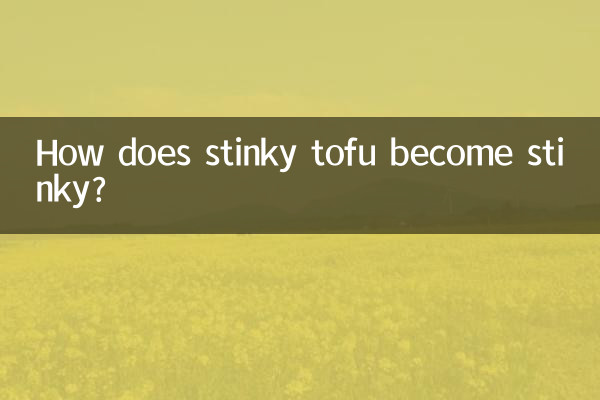How does stinky tofu become stinky?
Stinky tofu, as one of the traditional Chinese snacks, is famous for its unique "stinky smell", but many people are curious about its production process and the principle of "stinking". This article will combine the hot topics and hot content on the Internet in the past 10 days to reveal the source of the "stinky smell" of stinky tofu and its production process in the form of structured data.
1. The production process of stinky tofu

The production of stinky tofu is mainly divided into three key steps: material selection, fermentation, and frying. Fermentation is the core link of "stinking". Here's a breakdown of a typical production process:
| step | Operation content | time |
|---|---|---|
| 1. Selection of materials | Use fresh old tofu and cut into small pieces | 10 minutes |
| 2. Fermentation | Soak in brine (including amaranth stems, tempeh, etc.) | 1-7 days |
| 3. Fry | Fry at high temperature until the skin is crispy | 3-5 minutes |
2. The scientific principle of odor
The odor of stinky tofu mainly comes from the metabolites of microorganisms during the fermentation process. According to recent scientific research data, the key ingredients are as follows:
| Compound name | effect | Generating pathway |
|---|---|---|
| indole | Main components of fecal odor | protein breakdown |
| hydrogen sulfide | Rotten egg smell | Sulfur amino acid metabolism |
| propionic acid | pungent sour taste | Lactic acid bacteria fermentation |
3. Comparison of regional differences
The regional differences in stinky tofu recently discussed by food bloggers show that the brine formula and fermentation time in different regions directly affect the final flavor:
| area | Featured raw materials | Fermentation time | Taste characteristics |
|---|---|---|---|
| Changsha | Winter bamboo shoots, shiitake mushrooms | 2-3 days | Charred outside and tender inside |
| Shaoxing | Amaranth stems | more than 7 days | Strong smell |
| Taiwan | fruit peel | 1-2 days | Sweet and sour compound |
4. Hot topics of discussion among netizens
Based on social media data in the past 10 days, discussions about stinky tofu mainly focus on the following aspects:
1.food safety controversy: Some netizens are worried that traditional fermentation may produce harmful substances, but testing data shows that the nitrite content of stinky tofu produced by regular manufacturers is lower than the national standard.
2.Innovative ways to eat: The combination of "stinky tofu + mango" on a short video platform triggered more than 2 million discussions, and young people are more inclined to try cross-border combinations.
3.cultural export: With the popularity of #StinkyTofuChallenge on TikTok, stinky tofu has become a popular topic for foreign bloggers to experience Chinese food.
5. Tips for home production
According to the simplified version of the tutorial recently shared by the owner of Food UP, home production needs to pay attention to:
| Things to note | scientific basis |
|---|---|
| Control the room temperature at 20-25℃ | Avoid bacterial contamination |
| Use glass containers | Prevent metal ion reaction |
| The first fermentation should not exceed 24 hours | Reduce food safety risks |
Behind the "stinky smell" of stinky tofu is actually the magic of microorganisms and time. From a scientific perspective, this fermented food is rich in probiotics and amino acids and is beneficial to health when consumed in moderation. Next time you smell the "aroma" of stinky tofu, think about the unique flavor experience brought about by these complex biochemical reactions.

check the details

check the details